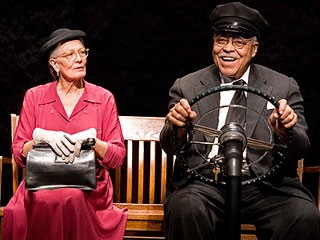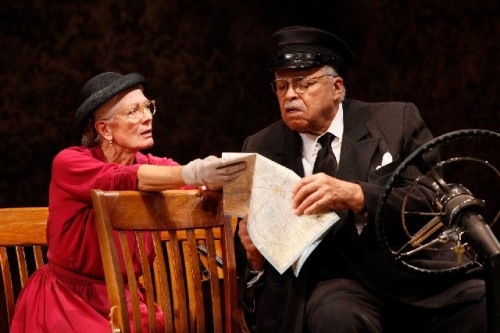Driving Miss Daisy Extended to April 29
James Earl Jones and Vanessa Redgrave
By: Charles Giuliano - Dec 16, 2010
Driving Miss Daisy
By Alfred Uhry
Directed by David EsbjornsonScenic Design, John Lee Beatty; Costume Design, Jane Greenwood; Lighting Design, Peter Kaczorowski, Projection Design, Wendall K. Harrington; Music, Mark Bennet; Sound Design, Christopher Cronin.
Cast: James Earl Jones (Hoke Colburn), Vanessa Redgrave (Daisy Werthan), Boyd Gaines (Boolie Werthan).
During a faltering season in a troubled economy “Driving Miss Daisy” with the dream cast of the aging Jewish matriarch, Vanessa Redgrave (Daisy Werthan) and her African American chauffeur, Hoke Colburn, performed by the iconic, James Earl Jones, has been a hit with audiences.
With a spate of shows closing early in the dead zone of January this show was to end in January. It has been extended to April 29.
It was indeed sublime to marvel at the miraculous performances of two of our greatest actors. Just close your eyes for a moment and take in the booming arc of Jones’s signature baritone. Or study the effortless nuance that Redgrave folds into every inflection and gesture. Rounding out the cast was the perfectly adequate Boyd Gaines as Daisy’s son Boolie.
The 1989 film, with Morgan Freeman and Jessica Tandy, was among the most evocative, flavorful and beloved of its era. There was such ironic restraint in the dignity of Freeman enduring the autocratic, self absorbed whims of the independent, elderly, Jewish, Southern lady.
Those remarkable performances are still so vivid that they too strongly overshadowed our efforts to accept the interpretations of Jones and Redgrave. It is always acceptable to rework the classics. But there is also wisdom in knowing when to leave well enough alone.
There is the further issue that the premise of the 1989 film, the growing but challenged relationship between a Jewish woman of privilege and her black driver, seems dated, forced, and cloyingly sentimental today.
The empathy between a Jewish woman and her black servant may have been more compelling a generation ago. Toward the end of the play she grasps his hand and say “You are my best friend.” Significantly, he reacts but fails to comment or respond. It is indeed an anachronistic moment.
Although an enduringly popular favorite the play by Alfred Uhry is hardly a classic. What emerged last night is that the play offered little incentive to evoke the remarkable skills and depth of two legendary actors.
There was the insistence of a time line. We watch as Daisy and Hoke grow old together. He starts driving for her when they are both 72. In the final scene she is toothless, wheelchair bound, and in her 90s. To convey these passages there are slide projections with vignettes of history. But these flashes, including a glimpse of Martin Luther King, proved to be too fleeting and disruptive.
The characters never work through any meaningful growth or conflict. There is no sense that they have really learned or changed. They remain remarkably unscathed by the terrible events of racism they endure. There is the bombing of a synagogue. And an evening in which Hoke delivers her to a Martin Luther King benefit dinner. There is a botched exchange as Daisy ineptly and insensitively, casually invites him to join her. Emotions and differences are touched on but not resolved.
There was interesting staging. To convey the all important car, or cars as it turns out over two decades, she is seated on a bench. Hoke drives from the front seat/ chair with a moveable steering wheel. The “car” is now and then rotated to simulate motion.
Ultimately, I was not particularly charmed by Redgrave’s prim and demanding Miss Daisy. Or the loyal Hoke of Jones who endured her whims and abuse as, dare we say this, a terribly charming, wise, all suffering and likeable Uncle Tom.
Yes, it was delightful to see two great actors explore their craft. There was genuine charm and compassion in their interaction. Surely they delight in this occasion to perform together. It was a memorable experience for the audience.
It was poignant and annoying to see two great artists reduced to mediocre popular culture. Significantly, the applause was polite but tepid. No standing O’s this time. It seems that some of the people…
\



